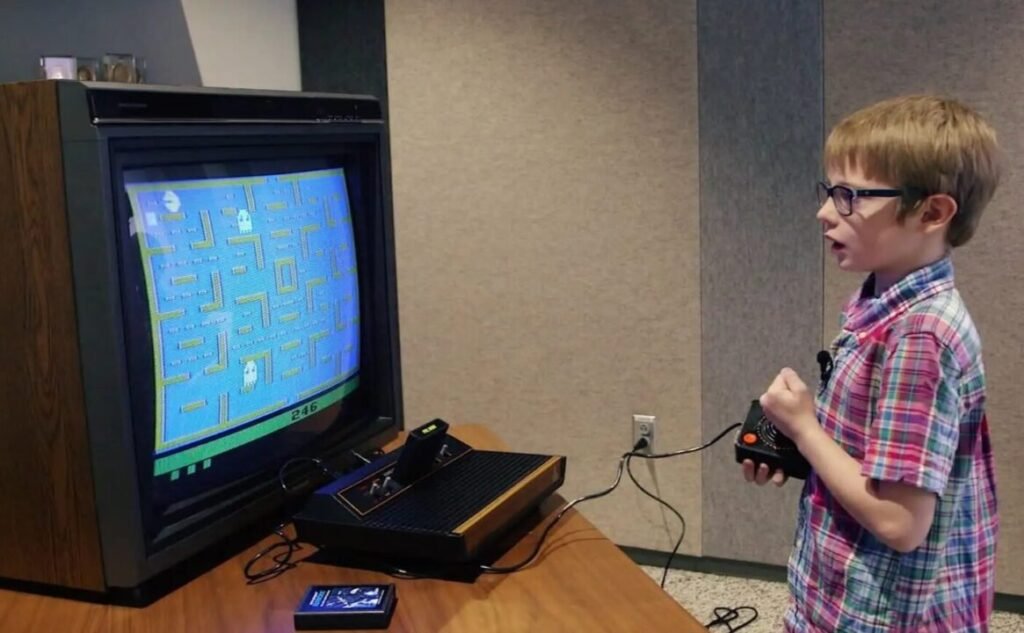Picture this: It’s 1982, the smell of popcorn hangs in the air, and neon lights flicker above a row of towering arcade cabinets.
The sounds of synthesized beeps, digitized explosions, and a catchy electronic melody fill the room. You step up, a fistful of quarters at the ready.
This is where legends were born, an era that spawned some of the most iconic and influential video games of all time.

The Arcade Revolution
The 1980s marked a revolution in gaming. Home consoles began their rise, but it was the arcade scene that defined the decade.
Simple yet captivating gameplay mechanics, bold pixel art, and instantly recognizable soundtracks created an entirely new form of entertainment.
They ignited our imaginations and laid the foundation for the multi-billion-dollar industry we know today. Let’s take a trip down memory lane and revisit the titans of the arcade era.
The Birth of Icons
- Pac-Man (1980): More than just a yellow circle munching on dots, Pac-Man became a global sensation. Its straightforward gameplay, addictive maze chases, and the instantly recognizable “waka-waka” sound are etched into gaming history.
- Donkey Kong (1981): This wasn’t just the debut of a barrel-hurling gorilla; it gave us Jumpman, who later evolved into Mario, arguably gaming’s biggest mascot. Iconic for its (at the time) challenging platforming and introduction of a narrative arc.
- Space Invaders (1978): While not the first, Space Invaders popularized the shoot ’em up genre. The relentless alien horde descending upon the player became a classic image, inspiring countless imitations.
The Pioneers Who Paved the Way
- Galaga (1981): A significant evolution of Space Invaders’ formula, with more complex enemy patterns and the iconic “capture” mechanic. Its colorful visuals and challenging gameplay solidified its place in history.
- Ms. Pac-Man (1982): Not just a palette swap, Ms. Pac-Man featured improved enemy AI, new maze layouts, and a female protagonist, a rarity back then. It demonstrated the power of even small iterations on beloved formulas.
- Asteroids (1979): Vector graphics and tense dogfights in the depths of space! Asteroids provided a different flavor of space-based thrills, focusing on maneuvering a lone ship against lethal space rocks.
- Defender (1981): Complex controls and fast-paced action defined Defender. It was renowned for its difficulty, pushing players to master its intricate systems for high scores and bragging rights.
- Tetris (1984): The ultimate puzzle addiction. Tetris transcended age groups and cultures with its universally understandable falling-block gameplay, proving that some of the most powerful game concepts lie in pure simplicity.
Beyond the Big Names
- Frogger (1981): The frantic rush to guide a frog across dangerous roads and rivers captivated players of all ages. Simple yet incredibly satisfying when you finally reached safety.
- Dig Dug (1982): Who knew that digging and inflating monsters could be so fun? Dig Dug offered a unique mix of strategy and action and a quirky, charming aesthetic.
- Tron (1982): Jumping straight out of the cult-classic film, Tron brought multiple, distinct minigames to the arcade, from light cycle races to disc battles, expanding the idea of what a single arcade cabinet could be.
- Zaxxon (1982): One of the first isometric games, Zaxxon impressed players with its forced perspective and pseudo-3D flight combat.
The Legacy of the 1980s
The 1980s arcade scene wasn’t just about individual games; it birthed gaming culture itself.
Arcades were social hubs where competition, camaraderie, and the thrill of discovery brought people together. These games didn’t just provide entertainment; they kickstarted an industry, inspired generations of developers, and continue to exert their influence on the games we play today.
Console Wars and the Dawn of Home Gaming
Console Wars and the Dawn of Home Gaming transformed the gaming landscape.
No longer confined to the arcade, players could embark on grand adventures from the comfort of their living rooms.
This shift fostered innovation and gave birth to unforgettable characters and groundbreaking franchises. Let’s revisit some of the defining titles of this transformative era.
The Rise of Home Consoles
While the arcade boom blazed, a quiet revolution was happening at home.
Consoles like the Atari 2600 and the Intellivision had paved the way, but it was the release of the Nintendo Entertainment System (NES) in 1985 that truly turned the tide. Home consoles offered a different experience: the chance to explore sprawling worlds at your own pace, save your progress, and master your favorite games without spending a fortune in quarters.
This shift changed the dynamics of the industry, sparking rivalry between console giants like Nintendo and Sega that would define the decades to come.
The console wars fueled innovation as each company strived to outdo the other, leading to groundbreaking games and beloved franchises.
The NES Era and Nintendo’s Dominance
- Super Mario Bros. (1985): More than a game, Mario became the symbol of Nintendo and a gaming icon recognized worldwide. Super Mario Bros. perfected the side-scrolling platformer, with tight controls, clever level design, and secrets to discover.
- The Legend of Zelda (1986): Hyrule captured our imaginations. Zelda pioneered the action-adventure genre, offering vast open-world exploration, puzzle-filled dungeons, and a memorable story.
- Metroid (1986): Atmospheric and mysterious, Metroid broke the mold with its non-linear world, powerful upgrades, and the surprise reveal that its protagonist, Samus Aran, was a woman.
- Mega Man (1987): Challenging but rewarding, Mega Man’s unique approach to level selection and stealing boss powers after defeating them made it a standout among action platformers.
Other Home Console Contenders
- Contra (1987): Brought the intensity of arcade shooters into the home. Run-and-gun action at its finest, Contra was known for epic boss battles and its infamous “Konami Code.”
- Castlevania (1986): Dark and gothic, Castlevania blended platforming with horror elements. Battling Dracula and mythical creatures with your trusty whip was pure 80s gaming goodness.
- Final Fantasy (1987): While not the first RPG, Final Fantasy’s rich world, memorable characters, and turn-based combat established a formula that shaped the genre for decades.
SEGA Makes Its Mark
- Alex Kidd in Miracle World (1986): Sega’s answer to Mario, Alex Kidd was whimsical, colorful, and filled with challenging platforming goodness.
- Phantasy Star (1987): An early pioneer in console RPGs, with sci-fi themes instead of traditional fantasy, Phantasy Star stood out from the crowd with its 3D dungeons and cinematic cutscenes.
- Sonic the Hedgehog (1991): To compete with Mario, Sega needed speed. Sonic the Hedgehog delivered, with blazing-fast levels focused on momentum and exploration, offering a thrilling alternative to Nintendo’s formula.
The Dawn of New Genres
- Punch-Out!! (1987): Rhythm and pattern recognition were key to mastering this addictive arcade boxing sim. Its quirky cast of opponents made it as memorable as it was challenging.
- Dragon Quest (1986): Wildly successful in Japan, Dragon Quest popularized traditional turn-based JRPGs, establishing tropes like inns for healing and townsfolk with hints, that still influence the genre today.
- SimCity (1989): While lacking traditional goals, SimCity was a revelation. It pioneered the city-building genre, letting players create and manage their own virtual metropolises.
The Seeds of the Future
The late 80s and early 90s saw the seeds planted for what was to come.
Fighting games like Street Fighter II would reignite the arcade scene, while technological advancements in 3D graphics and CD-ROMs hinted at gaming’s next evolutionary leap.
The console wars were just heating up, and as the decade came to a close, a new generation of unforgettable experiences was right around the corner.

Epilogue
The games of this era hold a special place in the hearts of many.
Their iconic characters, challenging gameplay, and catchy tunes still resonate with us. Whether you mastered the Mushroom Kingdom, explored the depths of Hyrule, or blasted your way through Contra, these games left an indelible mark.
They paved the way for the gaming experiences we love today and continue to inspire new generations of players and developers alike.

